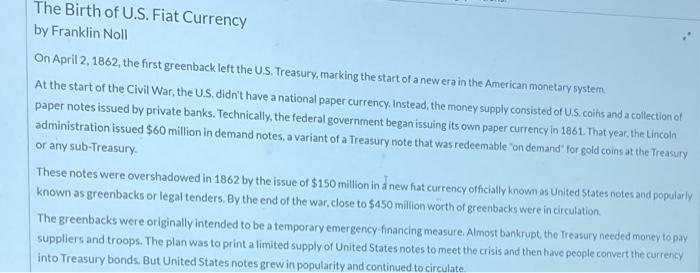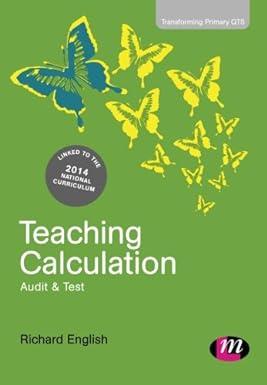The Birth of U.S. Fiat Currency by Franklin Noll On April 2, 1862, the first greenback left the U.S. Treasury, marking the start of a new era in the American monetary system. At the start of the Civil War, the US didn't have a national paper currency. Instead, the money supply consisted of U.S.coins and a collection ot paper notes issued by private banks. Technically, the federal government began issuing its own paper currency in 1861. That year the Lincoln administration issued $60 million in demand notes, a variant of a Treasury note that was redeemable on demand for gold coins at the Treasury or any sub-Treasury These notes were overshadowed in 1862 by the issue of $150 million in a new fiat currency officially known as United States notes and popularly known as greenbacks or legal tenders. By the end of the war, close to $450 million worth of greenbacks were in circulation The greenbacks were originally intended to be a temporary emergency-financing measure. Almost bankrupt, the Treasury needed money to pay suppliers and troops. The plan was to print a limited supply of United States notes to meet the crisis and then have people convert the currency into Treasury bonds. But United States notes grew in popularity and continued to circulate The name greenbacks referred to the reverse of the notes, which were printed in green. The name legal-tender notes referred to the text that originally appeared on the back, which began,"This note islegal tender for all debts, public and private. This provision made the currency a valid form of payment on par with gold and silver, which was a very controversial action at the time. It made the United States note a fiat currency meaning its value was established by law alone and wasn't based on some other unit of value, such as gold silver or land. Many Americans during and after the Civil War believed the creation of a fiat currency was unconstitutional. The Constitution explicitly stated that only gold and silver could be considered legal tender. In 1871, in the case of Knoxv. Lee, the Supreme Court settled the matter by declaring that making United States notes legal tender was indeed constitutional. By this time, the greenback was at the center of a countrywide debate on monetary policy. When the post-Civil War economic boom ended in the panic and depression of 1873, many people, especially farmers, blamed the Treasury's policy of contracting the currency - that is, removing United States notes from circulation in an attempt to go back to the gold standard, which would require that a $1 note could be redeemed for $1 in gold. As a consequence, there was a call for the expansion of United States note circulation or an inflation of the currency. This belief became joined with a political ideology that opposed big business and banking interests, resulting in the birth of the Greenback Party in 1874. Opposing the Greenbackers were more conservative interests, sometimes known as "gold bugs," who found support in the Republican Party and in elements of the Democratic Party Gold Interests proved the stronger contestant in the debate and in 1878, the total circulation of United States notes was fixed at a little over $346 million and the notes eventually became redeemable in gold (at least until 1933, when this provision was removed). During the 20th century, United States notes became ever less important in the nation's maney supply.though Congress supported their continued circulation. They were increasingly replaced by currency issued by the Federal Reserve System, which came to look almost identical to the United States note. The Federal Reserve note thus became the new greenback. In 1966, Congress allowed the Treasury to start removing United States notes from circulation. The last delivery of the notes by the Bureau of Engraving and Printing to the Treasury was made in 1971. In 1994, the Riegle Community Development and Regulatory improvement Act eliminated the issuance of the notes altogether. Today, original greenbacks can be found only in numismatic collections. But as the first federally issued fat currency, the United States note made possible the bills we still use every day. (Dr. Franklin Nollis president of Noll Historical Consulting and serves as the historian for the U.S. Bureau of Engraving and Printing. The opinions expressed are his own.) The federal government began issuing paper currency in 1861. In 1862, it issued s the nickname "greenbacks." million of a fat currency that gained By the end of the Civil War, close to S million in greenbacks were in circulation Greenbacks were originally only intended to be a temporary financing measure. To which form of money, according to this plan, would the monetary system eventually have returned? Choose one: O A Abarter system O B. Commodity money OCUS Treasury notes in circulation OD. Commodity-backed money












